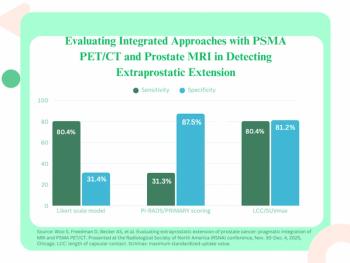Emerging research affirms the impact of pre-treatment prostate-specific membrane antigen (PSMA) positron emission tomography/computed tomography (PET/CT) on long-term survival rates for patients undergoing salvage radiotherapy (sRT) for biochemical recurrent prostate cancer (PCa).
For the study, recently published in the Journal of Nuclear Medicine, researchers reviewed data for 844 men who underwent sRT for biochemical recurrence of PCa. The study authors noted that PSMA PET/CT was utilized prior to sRT for 308 patients in the cohort. According to the study, 68Ga-PSMA-11 was utilized for 55 percent of the cohort and 18F-PSMA was incorporated for the remaining 45 percent of the patients.
The study authors found that patients who had PSMA PET/CT prior to sRT had higher survival rates at one year (100 percent vs. 99 percent), two years (99.5 percent vs. 97.8 percent) and five years (98.1 percent vs. 93.8 percent) in comparison to those who did not have pre-treatment PSMA PET/CT.
“Our analysis revealed that, despite their higher prevalence of pathologic lymph node involvement — a known predictor of poor survival — patients who underwent PSMA PET/CT before sRT treatment demonstrated greater 1-, 2-, and 5-(year) survival rates than those who did not,” wrote lead study author Anna W. Mogensen, M.D., who is affiliated with the Department of Nuclear Medicine in the Clinical Cancer Research Center at Aalborg University Hospital in Aalborg, Denmark, and colleagues.
Pre-treatment PSMA PET/CT was also associated with improved biochemical recurrence-free survival (BRFS). The researchers noted that patients who had PSMA PET/CT prior to sRT had a one-year BRFS of 91.3 percent and a three-year BRFS of 74.9 percent in contrast to 85 percent and 69.4 percent, respectively, for patients who didn’t have PSMA PET/CT.
“These BRFS rates corresponded to a relative risk reduction of 42% after 1 (year) of follow-up and 18% after 3 (years),” pointed out Mogensen and colleagues.
(Editor’s note: For additional content on prostate cancer imaging, click here.)
Three Key Takeaways
- Survival benefit. Pre-treatment PSMA PET/CT prior to salvage radiotherapy (sRT) for biochemical recurrent prostate cancer was linked to higher overall survival at one, two, and five years, despite a higher rate of pathologic lymph node involvement in this group.
- Improved BRFS. Patients undergoing pre-sRT PSMA PET/CT demonstrated superior biochemical recurrence-free survival with a 42 percent relative risk reduction at one year and an 18 percent reduction at three years compared to those without PSMA PET/CT imaging.
- Facilitating improved patient selection for sRT procedures. Findings suggest PSMA PET/CT can aid in better patient selection for sRT, potentially optimizing treatment outcomes for those most likely to benefit.
Noting that the study may have been the first to directly compare sRT survival outcomes between patients who had pre-treatment PSMA PET/CT and those who did not, the researchers said the cohort included the entire population of patients in Denmark who underwent sRT during the study period.
“Our findings highlight the value of PSMA PET/CT in the pre-sRT selection process to select patients likely to benefit from this treatment,” added Mogensen and colleagues.
(Editor’s note: For related content, see “SNMMI: 18F-Piflufolastat PSMA PET/CT Offers High PPV for Local PCa Recurrence Regardless of PSA Level,” “The Reading Room Podcast: Emerging Trends with Theranostics in Prostate Cancer, Part 1” and “SNMMI: What a New Meta-Analysis Reveals About Radiotracers for PET/CT Detection of PCa.”)
In regard to study limitations, the authors acknowledged the observational study design, possible lead time bias due to regional variability with PSMA PET/CT use and an inability to control for certain confounding factors.




























